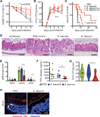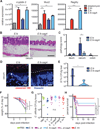Exploiting a host-commensal interaction to promote intestinal barrier function and enteric pathogen tolerance
- PMID: 28580440
- PMCID: PMC5453653
- DOI: 10.1126/sciimmunol.aai7732
Exploiting a host-commensal interaction to promote intestinal barrier function and enteric pathogen tolerance
Abstract
Commensal intestinal bacteria can prevent pathogenic infection; however, limited knowledge of the mechanisms by which individual bacterial species contribute to pathogen resistance has restricted their potential for therapeutic application. Here, we examined how colonization of mice with a human commensal Enterococcus faecium protects against enteric infections. We show that E. faecium improves host intestinal epithelial defense programs to limit Salmonella enterica serotype Typhimurium pathogenesis in vivo in multiple models of susceptibility. E. faecium protection is mediated by a unique peptidoglycan hydrolase, SagA, and requires epithelial expression of pattern recognition receptor components and antimicrobial peptides. Ectopic expression of SagA in non-protective and probiotic bacteria is sufficient to enhance intestinal barrier function and confer resistance against S. Typhimurium and Clostridium difficile pathogenesis. These studies demonstrate that specific factors from commensal bacteria can be used to improve host barrier function and limit the pathogenesis of distinct enteric infections.
Figures






Similar articles
-
Enterococcus faecium secreted antigen A generates muropeptides to enhance host immunity and limit bacterial pathogenesis.Elife. 2019 Apr 10;8:e45343. doi: 10.7554/eLife.45343. Elife. 2019. PMID: 30969170 Free PMC article.
-
A secreted bacterial peptidoglycan hydrolase enhances tolerance to enteric pathogens.Science. 2016 Sep 23;353(6306):1434-1437. doi: 10.1126/science.aaf3552. Epub 2016 Sep 22. Science. 2016. PMID: 27708039 Free PMC article.
-
Morphine withdrawal lowers host defense to enteric bacteria: spontaneous sepsis and increased sensitivity to oral Salmonella enterica serovar Typhimurium infection.Infect Immun. 2006 Sep;74(9):5221-6. doi: 10.1128/IAI.00208-06. Infect Immun. 2006. PMID: 16926415 Free PMC article.
-
Commensal bacteria (normal microflora), mucosal immunity and chronic inflammatory and autoimmune diseases.Immunol Lett. 2004 May 15;93(2-3):97-108. doi: 10.1016/j.imlet.2004.02.005. Immunol Lett. 2004. PMID: 15158604 Review.
-
Immunometabolic Phenotype Alterations Associated with the Induction of Disease Tolerance and Persistent Asymptomatic Infection of Salmonella in the Chicken Intestine.Front Immunol. 2017 Apr 4;8:372. doi: 10.3389/fimmu.2017.00372. eCollection 2017. Front Immunol. 2017. PMID: 28421074 Free PMC article. Review.
Cited by
-
Microbial transmission in the social microbiome and host health and disease.Cell. 2024 Jan 4;187(1):17-43. doi: 10.1016/j.cell.2023.12.014. Cell. 2024. PMID: 38181740 Free PMC article. Review.
-
Functional Multigenomic Screening of Human-Associated Bacteria for NF-κB-Inducing Bioactive Effectors.mBio. 2019 Nov 19;10(6):e02587-19. doi: 10.1128/mBio.02587-19. mBio. 2019. PMID: 31744921 Free PMC article.
-
Postbiotics From Lactobacillus Johnsonii Activates Gut Innate Immunity to Mitigate Alcohol-Associated Liver Disease.Adv Sci (Weinh). 2025 Jan;12(2):e2405781. doi: 10.1002/advs.202405781. Epub 2024 Nov 22. Adv Sci (Weinh). 2025. PMID: 39574408 Free PMC article.
-
Enterocloster clostridioformis protects against Salmonella pathogenesis and modulates epithelial and mucosal immune function.Microbiome. 2025 Feb 28;13(1):61. doi: 10.1186/s40168-025-02050-9. Microbiome. 2025. PMID: 40022210 Free PMC article.
-
Microbiota mechanisms in cancer progression and therapy.Cell Chem Biol. 2025 May 15;32(5):653-677. doi: 10.1016/j.chembiol.2025.04.005. Epub 2025 May 6. Cell Chem Biol. 2025. PMID: 40334660 Review.
References
Grants and funding
LinkOut - more resources
Full Text Sources
Other Literature Sources
Molecular Biology Databases

